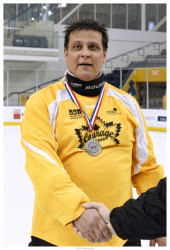Article Origin
Volume
Issue
Year
Though he’s now in his 50s, Roland Arndt can still score his share of hockey goals. Even if he can’t see the puck for large portions of the game.
Arndt, a 52-year-old Ojibwe who lives in Toronto, has Stargardt disease, a macular degeneration that causes progressive vision loss. He began to lose his sight in his late teens and now only has about 10 per cent vision in each eye.
But he continues to play an adapted version of hockey. He was one of 76 players that competed in the Courage Canada national blind hockey tournament, which concluded on Feb. 15 in Toronto. Courage Canada is a charity which provides visually-impaired youth the opportunity to learn to skate and play blind hockey.
As for the national tournament, which featured six teams, it was staged at the Mattamy Athletic Centre, formerly Maple Leaf Gardens.
“I can see the puck if it is within range,” Arndt said. “But if it goes down the ice, I don’t have a clue where it is.”
For obvious reasons, there are a few alterations made for those that compete in blind hockey.
For starters, the puck is considerably larger than a normal puck. Various versions of a puck utilized in blind hockey games have been used in recent years.
This includes the tires from barbecue stands. At this year’s tournament a light metal puck, about three times the size of a normal rubber puck, was utilized.
As with other types of blind hockey pucks, the one used at games this year included ball bearings inside so it can rattle when it is moving so players with limited or no vision can hear where the puck is if they cannot see it.
Also, to assist goalies who have difficulties keeping track of the fast-moving puck, players are not allowed to shoot the puck high into the air in order to try and score. In fact, the top portions of the net are partitioned off with a cover. Players can only score by shooting into the lower parts of the net.
Besides a half-dozen players from the United States, this year’s national tournament attracted players from British Columbia, Alberta, Saskatchewan, Ontario, Quebec, Nova Scotia and Newfoundland.
“The tournament is getting huge now,” Arndt said, adding in some previous years there were only entrants from B.C., Ontario and Quebec.
The participating clubs were named after provinces or regions of Canada. And the competitors, who range in age from 14 to 80, †were not necessarily placed onto teams from where they are from.
For example, Arndt was on Team Atlantic.
Organizers attempted to balance the teams by how much sight players had. They attempted to give each club an equal amount of totally blind, mid to low, and relatively high vision players.
Arndt scored five goals for his club in its first three games. Team Atlantic won all of these contests.
But Arndt and his teammates were defeated 4-1 by Team Quebec in the gold-medal match.
“I was pretty banged up in that final game,” Arndt said.
The day before the gold-medal game Arndt was tripped by an opposing player in a game. He did a complete flip in the air before crashing to the ice.
Arndt said that incident affected his performance in the final.
“It was rough for me,” he said. “I was pretty stiff. And I had a rough time out there.”
Arndt was still hurting several days later but had not gone to see a doctor.
“I definitely know I’ve got some bruised ribs,” said Arndt, who works as a recreation therapist at a seniors home. “But I haven’t had time to get it checked yet.”
Arndt has been playing blind hockey with the Toronto Ice Owls for almost a decade now. The team plays once a week from October through March.
Because of work commitments, however, Arndt is only able to join the team every two weeks.
“I’m definitely slowing down,” he said. “The kids are getting a lot younger and faster. I can still hold my own out there. But I don’t have the speed I used to have. And I don’t have the stamina I used to have.”
Canada is currently the only country that has a national blind hockey tournament.
Arndt, and those who govern the sport here, would love to see the game expand to other nations.
“I can see it becoming more popular,” he said. “The word just has to get out there. And more of our games just have to be streamed online. They figure in eight, 10 years it might get to be a Paralympic sport.”
- 2424 views

